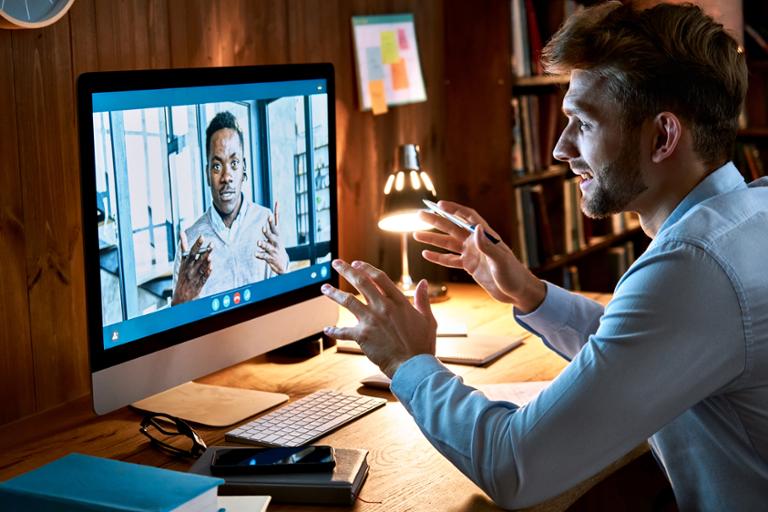Even before the pandemic, video interviews were an extremely common event when hunting for a new tech job. For those just beginning their tech career, what does the video interview process look like, and how can you ensure that you do your best in those kinds of situations?
It’s important to understand that many companies prefer video conferencing (whether via Google Hangout, Microsoft Teams, or some other software) to a phone screening. It’s easy to see why: video interviews allow the job seeker and the hiring manager to see one another, which can help them better understand the other’s reactions and emotions.
For tech candidates, the video interview has other advantages. In the midst of a busy job search, they’re easy to schedule, and you can do them out of your home (provided you have a solid internet connection and can keep family members from interrupting, of course). If you’re applying for a remote job, a video interview will be your first taste of what it’s like to work at a particular company. With that in mind, here are some handy tips for getting the most out of your video interviewing experience.
Choose an Appropriate Location
Think about where you’re going to do your video interview in advance. Since you aren’t in an office, you need to be particularly careful about what your interviewer sees behind you. What you don’t want in your picture is anything that the person will look at and wonder about. You don’t want them thinking “Are those dirty socks on that chair?” or “What’s that a picture of?” Any time spent thinking about that is time spent not thinking about what you’re saying.
Consider the sound as well. Will you be able to hear one another? Will there be any distracting sounds? Is there an echo? Will your friend’s band be practicing in the next room? Oh, and if the space isn't a private one, makes sure your friends or family members know not to disturb you. You don’t want your buddy Kurt bursting in to announce that “It’s gravity bong time,” because that could seriously be detrimental to your cause.
Choose Your Device and Set up a ‘Tech Checklist’
There’s nothing worse or more embarrassing than scrambling at the last minute because you’re having problems with your tech or your internet connection. To that end, decide on a few things before your interview:
- Which device will you use? With a plugged-in laptop, you won’t have to worry about suddenly running out of battery power in the middle of an interview, and you can easily access your browser and apps during the interview.
- How fast is your internet? If you live in a place with internet issues, you should consider doing the interview someplace else, such as a friend’s house or a conference room in a co-working space.
- Have you updated your software and settings? Note the software utilized by your interviewer. Is your own copy of Zoom, Teams, etc. up-to-date? Can your browser support a video call? Update your software and system well in advance of the interview, especially if you’ll be expected to open a second browser screen during the interview, download an app, or similar activity.
- What happens if something goes wrong? Things go haywire despite everyone’s best intentions. Before the interview, make sure you have a plan (and even a short script) to call the interviewer back if the signal is dropped, for instance, or if someone interrupts. Getting a backup phone number from an interviewer is always a useful tip.
Do a Test Run
Call your mom, call a friend, just make sure that you’re all set to make the call on the day of the interview. You might also want to review who’s supposed to call whom, and make sure that you know what that will entail.
And while you’re doing your test run, why not hit record? Play back your recorded answers, see how you look and sound, and make any necessary tweaks. Does your background look the way you expected? How’s your volume? Have you framed your shot in an appealing way? And for the record, the appealing way is straight on: no shooting from your lap straight up your nose and no Hitchcockian crane shots from above. Just have the camera directly at your eye level.
I know watching yourself interview can be kind of cringe-worthy, but it lets you see for yourself how you look to others, and it really is the best way to improve.
Body Language and Eye Contact are Key
Another thing to prepare for is eye contact. Good eye contact in a standard interview can be tough, but in a video it’s even harder because it feels so awkward. To maintain eye contact, you need to look into the camera the whole time, and not the person’s eyes. If you’re looking at their image on the screen, you’re actually looking down the whole time. So even if you’re looking directly at them, it’s not going to look like that to them. Practice definitely makes perfect on this front.
Consider your body language: you’ll want to sit up straight and lean slightly toward the camera, both of which will convey that you’re engaged with the interviewer. With video calls, it’s also important to keep any gestures small, because the camera tends to magnify movement; sweeping your arms, for instance, may seem aggressive. And don’t forget to smile, laugh, and otherwise convey a sort of natural humanity.
Dress Appropriately
Dress appropriately, just as if you were going into the office. Not only will you look the part to your interviewer, but you’ll get yourself into the interviewing mindset, which can be difficult when you’re in the comfort of your own home and wearing your pajama pants. This is an interview, and it’s probably your first with the company. So make sure that the impression you’re making is the best. Follow these tips, and you’ll have the interviewer’s full attention for all the right reasons. And the, you’re golden! As long as, well, you also say the right things.



